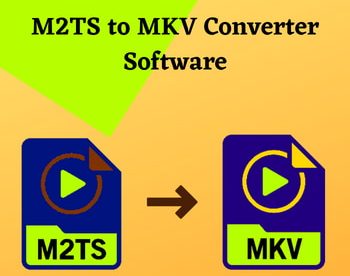5 Best Free Social Network Analysis Software for Windows
Here is a list of best free social network analysis software for Windows. Social network analysis is a process of analyzing social networks using network and graph theory. By using these social network analysis software, you can perform analysis on input social network data and graphs. For analyzing social networks, these software provide various analysis tools which extract desired values from the input data to make analysis easier. Some of the important statistics that these software provide are node density, node strength, link strength, dynamic statistics, etc. Along with statistics, you also get a visual representation of the input network data that also helps in the analysis. In most of these software, you can also manually create as well as edit network graphs.
These software generally take input social network data in GraphML, CSV, GML, and GraphWiz file formats. After the analysis and editing existing network data or graph, you can save or export the data as GraphML, GML, BMP, PNG, etc. formats. Overall, all of these are fully capable of analyzing any type of network data and file.
My Favorite Social Network Analysis Software For Windows:
SocNetV is my favorite software because it lets you analyze most aspects of the social network graph without making the analysis too complex. Along with analysis, it also lets you create a network graph.
You can also check out lists of best free Statistical Analysis, Stock Analysis, and Motion Analysis software for Windows.
SocNetV
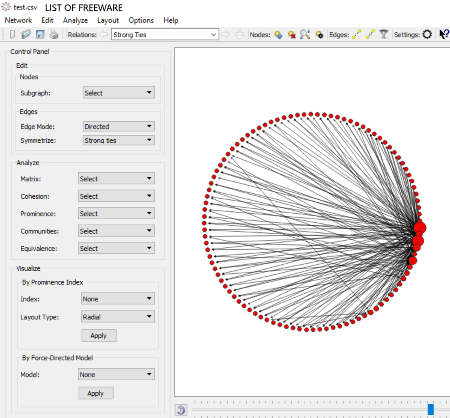
SocNetV is a free social network analysis software for Windows. Using this software, you can analyze various types of social networks such as social media networks, friendship and acquaintance networks, collaboration graphs, meme spreads, and more. In it, you can also create a new network with various nodes and connecting lines (edges), and also analyze it. Plus, you can also visualize your network which further helps you study the network.
In this software, you can load various types of network data containing files such as GraphML, GML, UCINET, Pajek, GraphViz, Simple Edge List, etc. After loading the file, you will immediately get a visual representation of the network on its interface. Now, to analyze the network, go to its Analyze Menu and use different analyzing tools namely, Adjacency Matrix and Matrices, Cohesion, Centrality and Prestige Indices, and Structural Equivalence.
Let’s take a brief look at all available analysis tools:
- Adjacency Matrix and Matrices: Using this tool, you can convert network data in the form of the adjacency matrix, invert adjacency matrix, and transpose adjacency matrix to analyze the data.
- Cohesion: This tool allows you to analyze the cohesion between various nodes of the network using options like reciprocity test, symmetry test, average distance, eccentricity, total walks, etc.
- Centrality and Prestige Indices: Using it, you can analyze various indices of a network such as a degree centrality, closeness, stress centrality, information centrality, degree prestige, etc.
- Structural Equivalence: This tool helps you analyze and compute the Pearson product moment correlation coefficients between rows, columns, and social network matrix. Along with this, you can also analyze Hierarchical Clustering, Tie Profile Distances, and Similarity by the measure of the graph.
Visone
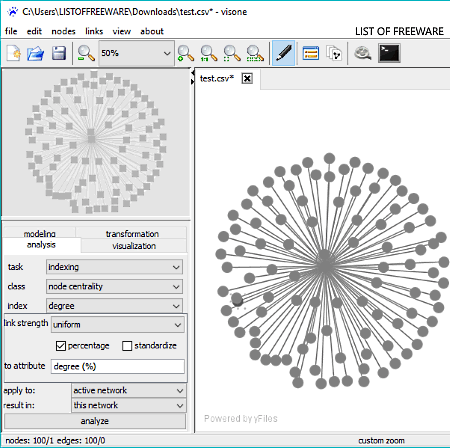
Visone is another free social network analysis software for Windows. In this software, you can create, transform, explore, analyze, and represent a network data. In it, you can either create a new social network design or import a network data file for the analysis. The process of creating a new network design is quite simple. By enabling the edit mode, you can easily add network nodes on the canvas with help of mouse and by using its attributes manager, you can also add values of all attributes of a node. The created graph can also be exported in many formats such as PNG, JPG, BMP, PDF, SVG, EMF, etc.
To analyze a social network, first, you need to import a social network data file of GraphML, CSV, VSN, etc. format. After importing the file, you will get a visual representation of the network data along with various data analysis sections (Analysis, Modeling, and Visualization). You can access all the data analysis sections from the left side panel of the interface. In the analysis section, you can analyze indexing and grouping tasks along with classes (node density, node strength, node hierarchy, etc.), link strength, and attributes. In the modeling section, you can view and analyze data specification, individual covariates, and dyadic covariates. The visualization section helps you change the visual representation of the network graph according to different categories, layout, and node layout. Plus, options to check the stability and orthogonal ordering constraints of the network graph are also available.
Overall, it is another handy social network analysis software through which you can analyze various aspects of a social network.
Cytoscape
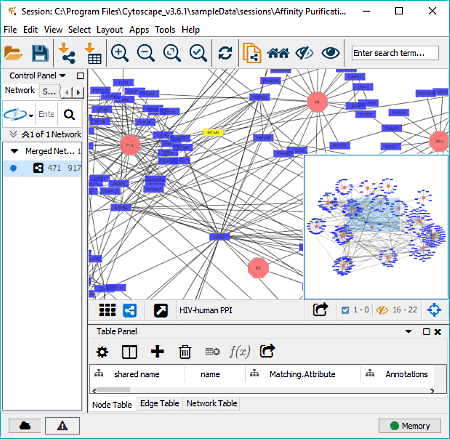
Cytoscape is a free open source social network analysis software for Windows. The software is mainly developed for biological research like visualizing molecular network interaction, gene expression profiles, etc. Now, it is also used as a general platform for complex network analysis and visualization.
In order to perform the analysis, you need to import a social network file or enter the URL of a social network. The visual representation of the imported data can immediately be viewed on its interface. The main analysis tool named Network Analyzer is present in the Tools menu of this software. Using this tool, you can easily view all the statistics of the network, treat the network as a directed or undirected graph, and generate style from statistics. Apart from this, one additional tool namely Workflow (to analyze the selected network and create custom types) can also be used for the analysis of the certain network parameters. This software also provides a table panel along with a network diagram on the main interface. From the table panel, you quickly find out all matching attributes, human-readable error, degree, betweenness, etc., of the network which further help in analysis.
After the analysis, you can export all the network data as CX JSON, NNF, GraphML, SIF, etc. formats.
Gephi
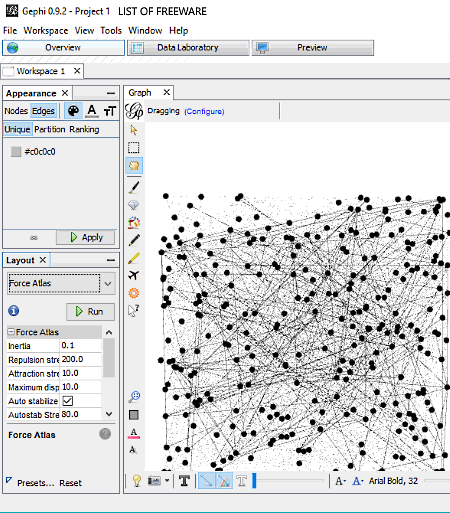
Gephi is another free open source social network analysis software for Windows. It is not only used to analyze the social network, but also for the analysis of exploratory data, link, and biological network. In it, you get various dedicated statistics section to extract and analyze various aspects of the social network. All the statistics are available on the Statistics section which is present on the right side of the interface. In the statistics section, you mainly get four types of network statistics namely Network Overview Statistics, Node Overview Statistics, Edge Overview Statistics, and Dynamic Statistics.
Let’s take a look at all four network statistics types which help in analyzing a social network:
- Network Overview Statistics: In this type, you can find out average degree, network diagram, graph density, modularity, page rank, connected components, etc.
- Node Overview Statistics: It shows average clustering coefficient and eigenvector centrality values.
- Edge Overview statistics: From here, you can view average path lengths of both directed and undirected social network graph values.
- Dynamic Statistics: This shows node, edge, degree, and clustering coefficient statistics of only dynamic social network data or graphs.
Apart from analyzing social network, you can also create a social network graph from scratch. All the created or modified graphs can easily be exported as Graph file, PDF, SVG, and PNG files. Overall, it is simple and easy to use social network analysis and creation software.
Network Workbench Tool
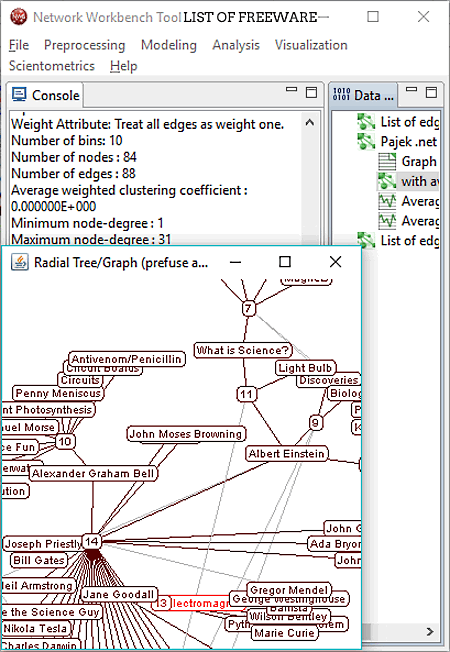
Network Workbench Tool is the next free network analysis software for Windows. This software is created for network scientists to perform network analysis, modeling, and visualization. In this software, you can analyze networks of biomedical, social science, and physics fields.
To analyze various aspects of a social network, it provides a tab named Analysis. In the analysis tab, you get various tools namely Network Analysis Toolkit (NAT), Unweighted and Undirected, Weighted and Directed, Unweighted and directed, Discrete Networks Dynamics, etc. By using its Network Analysis Toolkit, you can find out weakly connected component, largest connected component, network density, numeric attributes, and more important statistics. All combinations of weighted and unweighted tools basically provide data like node degree, degree distribution, diameter, average shortest path, page rank, strong component clustering, etc. By using all the available statistics and data, you can analyze every aspect of a social network graph.
Apart from the analysis, it also provides a Visualization Tab to view the graph structure. Plus, options to view the graph as Radial Tree, Treemap, Baloon Graph, etc., are also present. A Modeling section is also present to quickly plot a random graph and study its characteristics. In general, it is a feature-rich network analysis software through which an experienced user can extract every information from an input network graph or data.
Naveen Kushwaha
Passionate about tech and science, always look for new tech solutions that can help me and others.
About Us
We are the team behind some of the most popular tech blogs, like: I LoveFree Software and Windows 8 Freeware.
More About UsArchives
- May 2024
- April 2024
- March 2024
- February 2024
- January 2024
- December 2023
- November 2023
- October 2023
- September 2023
- August 2023
- July 2023
- June 2023
- May 2023
- April 2023
- March 2023
- February 2023
- January 2023
- December 2022
- November 2022
- October 2022
- September 2022
- August 2022
- July 2022
- June 2022
- May 2022
- April 2022
- March 2022
- February 2022
- January 2022
- December 2021
- November 2021
- October 2021
- September 2021
- August 2021
- July 2021
- June 2021
- May 2021
- April 2021
- March 2021
- February 2021
- January 2021
- December 2020
- November 2020
- October 2020
- September 2020
- August 2020
- July 2020
- June 2020
- May 2020
- April 2020
- March 2020
- February 2020
- January 2020
- December 2019
- November 2019
- October 2019
- September 2019
- August 2019
- July 2019
- June 2019
- May 2019
- April 2019
- March 2019
- February 2019
- January 2019
- December 2018
- November 2018
- October 2018
- September 2018
- August 2018
- July 2018
- June 2018
- May 2018
- April 2018
- March 2018
- February 2018
- January 2018
- December 2017
- November 2017
- October 2017
- September 2017
- August 2017
- July 2017
- June 2017
- May 2017
- April 2017
- March 2017
- February 2017
- January 2017
- December 2016
- November 2016
- October 2016
- September 2016
- August 2016
- July 2016
- June 2016
- May 2016
- April 2016
- March 2016
- February 2016
- January 2016
- December 2015
- November 2015
- October 2015
- September 2015
- August 2015
- July 2015
- June 2015
- May 2015
- April 2015
- March 2015
- February 2015
- January 2015
- December 2014
- November 2014
- October 2014
- September 2014
- August 2014
- July 2014
- June 2014
- May 2014
- April 2014
- March 2014


